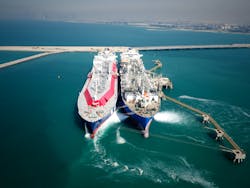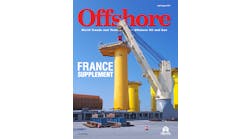GTT membranes safeguard LNG on Prelude, Coral South
Most of the newbuild FSRU and FLNG vessels either in operation or under construction worldwide employ GTT’s membrane containment systems for their LNG/LPG cargoes.
GTT (Gaztransport & Technigaz) was formed in 1994 following the merger between two French companies Gaztransport and Technigaz, both focused on the LNG shipping business. The company originally developed its membrane technologies to reduce the cost of LNG maritime transport by loading it in bulk in the LNG carrier’s holds. The holds are equipped with cryogenic coatings, or membranes, which contain the LNG at a temperature of -163°C (-261°F) and are sealed with an impermeable layer between the liquid cargo and the vessel’s hull. The design also limits cargo loss through evaporation, or boil-off.
GTT’s sustained research and development efforts have led to it designing new solutions for the LNG offshore industry, especially for LNG floating storage and regasification units (FSRU) and floating liquefied natural gas vessels (FLNG).
It is important for GTT to develop its technology to meet their customer’s requirements which are changing and evolving quickly. More resistant insulation systems are necessary to enable operations offshore (FLNG, FSRU, etc.), in order to obtain more operational flexibility or even to transport gases which are heavier than LNG.
In recent years the company introduced its Mark III Flex+ system, engineered to provide improved thermal performance. The design evolution involved the increase of the total thickness of the insulation by 20% compared to the established Mark III Flex system.
Another on-going development, which received initial approval from Class in late 2018, is GTT NEXT1, which is designed to achieve a thermal performance equivalent to Mark III Flex while using proven materials and components of NO96 system (the other GTT’s technology).
According to the company, over 30 FSRU vessels currently operate globally, with countries new to LNG imports generally favoring the concept as more economic than construction of full-scale onshore storage. The company claims that all units currently being built will also feature its technologies. As for FLNG (floating LNG) vessels, only a few are in service: GTT equipped 10 Mark III tanks to Shell’s Prelude, the world’s largest FLNG vessel, and delivered systems for Petronas’ two smaller FLNG vessels operating offshore Malaysia. In addition, GTT technologies will be fitted to the first ultra-deepwater FLNG, under construction by Samsung in South Korea for Eni’s Coral South gas field in 2,000 m (6,562 ft) water depth in Area 4 of Mozambique’s offshore Rovuma basin. The facility is due to start operations from mid-2022, producing 3.4 MM metric tons/yr (3.75 MM tons/yr) of LNG over a designed lifespan of 25 years.
GTT has licensed its membrane technology to leading Far East shipyards including Samsung, Hyundai Heavy Industries, DSME, Hudong Zonghua, and Jiangnan. Last December, it also signed a technical assistance and license agreement with Wison Offshore & Marine in China to equip FLNGs, FSRUS, floating storage, regasification and power generation units and other vessels with its membrane containment systems. Teams of the licensed partners are then trained by GTT in the principles of membrane installation.
According to GTT’s Commercial Vice President David Colson, the company undertakes most of its R&D at its headquarters in St Rémy-lès-Chevreuse south of Paris. “We study the materials that go into the containment system: all selected materials and developed sub-assemblies then have to be qualified and tested at room and cryogenic temperatures. We then approve suppliers and shipyards for the fabrication process.
“Our facilities include a liquid motion/sloshing laboratory with four machines designed to simulate all the different movements of the LNG vessel, with 6 degrees of freedom. We use a 1/40 scale tank, equipped with pressure sensors, to measure at laboratory scale how the liquid in the tank would behave on an offshore vessel or platform. We can then optimize the membrane system design through reinforcements or to propose modifications to the design of the platform itself through changes in the dimensions or adding stability. GTT also works with universities in Europe if we do not have the necessary equipment in-house.
“Offshore ship-owners are less concerned about improving thermal performance to reduce the boil-off rate (a prime concern for LNG carriers; matching the boil off to the engine requirements). However, the thermal performance of tanks can be an issue for offshore re-gas applications as a resultant boil-off situation could halt a send-out of an FSRU.”
A different approach is required for modeling sloshing on offshore re-gas/FLNG vessels, Colson explained. “With an LNG carrier, you typically operate it up to 10% of tank height when on ballast, and not below 70% on laden voyages. But for offshore vessels, you must be able to maintain the filling height in all conditions. So we must demonstrate to the client that our system can perform sufficiently well to meet all sloshing requirements under the offshore environment.”
“At the start of FLNG development, some years ago”, he continued “GTT’s technology was not viewed as optimal for for such a platform, particularly for withstanding sloshing in FLNG units, and the company had to demonstrate to Shell, amongst others that its membrane containment systems could be adapted to work on the Prelude project offshore northwest Australia. Instead of the conventional arrangement of one row of four to five LNG storage tanks, the design of a central cofferdam solution between two rows of five tanks extending the length of the platform was adopted. This solution reduces the risk of sloshing loads as well as acting as structural support for the platform’s very heavy topside. Other tank solutions, such as spherical tanks, would not afford enough flat deck space to accommodate the topsides.” Other alternative solutions which do feature a flat deck, have been, according to Colson, considered to be more expensive.
“In a scenario of two banks of normally dimensioned 50-m (164-ft) wide tanks, there would be a potential for quite an important amount of liquid motion at certain filling levels. But if the tank breadths are halved, it reduces the sloshing effect significantly. In addition, FLNG vessels are massive, stable structures that do not move excessively in water compared to normal vessels.”
The redundancy built into the design means that nine of the tanks can continue to operate normally while the other tank is taken off line to be emptied of gas. The process entails visual inspections and checks for tightness, with maintenance and repairs, if required, performed on site. “If there is an issue at the higher part of the tank,” Colson said, “our team may have to erect scaffolding in the tank on site, because the vessel cannot be brought ashore at any time for dry-docking.”
“Our membrane systems on all our clients’ vessels are constantly monitored for any potential leak in the tank or barrier. We also conduct visual checks to verify that there are no objects in the tank which could become loose. A bolt which has become unbolted may lead to damage under sloshing in operation.”
GTT has also been awarded a contract with Shell to maintain the tanks on Prelude on a five-yearly basis.
For LNGC’s, FSRUs and FLNGs, GTT subsidiary Cryovision provides different types of membrane test services such TAMI (Thermal Assessment of Membrane Integrity) for testing the tightness of tank secondary barrier as well as other tightness tests (Primary barrier, Global tank test). The company may also use in-tank equipment to facilitate testing such as: MOON (Motorized BalloON) operates in similar fashion to a drone. In this case, a balloon is dispatched to inspect a tank’s primary membrane. TIBIA (Tank Inspection by Integrated Arm) is an arm-like tool developed by GTT that can roam around tanks on FSRUs and FLNGs and perform maintenance of the primary membranes.
GTT continues to offer innovative services for monitoring and maintaining the membrane tanks offshore. Recently GTT North America signed a five-year global technical services agreement with Excelerate Energy to support maintenance of nine FSRUs equipped with NO96 membrane technology. •



